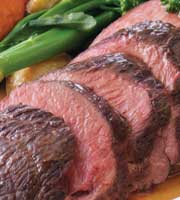 New Scientist magazine has just published an article about the sustainability of kangaroo meat for human consumption. If you’re interested read it now, as I think free access to the full article is removed at some period after publication.
New Scientist magazine has just published an article about the sustainability of kangaroo meat for human consumption. If you’re interested read it now, as I think free access to the full article is removed at some period after publication.
The article looks at issues like methane production, water use, feed conversion efficiency, orphaned joeys, humane harvesting, etc and draws comparisons with traditional meat livestock. After weighing up the issues, it comes down in favour of ramping up kangaroo production, with the 10-year-vegetarian author finally succumbing happily to a plateful of kangaroo stroganoff.
I wrote about the sustainability of kangaroo meat a while ago, and this article backs up my thoughts.
What about you? Have you tried kangaroo? What do you think? Could it replace traditional meat livestock, or do you see it as more of an occasional treat, like venison?
I tasted kangaroo when I was in Australia a decade ago, but I was nearly a vegetarian then and thought it was like any other meat. I’m curious to hear whether kangaroo makes sense in other climates or just in Australia? Should I be considering kangaroo here instead of sheep or pigs?
@Anna: Kangaroo probably wouldn’t suit you there. They don’t travel well at all (they’re very susceptible to stress, and suffer “capture myopathy”), and their reproduction rate is slower than sheep or pigs. They’re also impossible to fence in for a reasonable cost. But here in Australia, where we have so many of them, sustainable harvesting makes sense.
I quite like kangaroo – I’ve had steaks and sausages made from it. Oh and a rather nice “coat of arms” salami from kangaroo and emu.
I don’t think it could replace cows or sheep on the industrial farming level – kangaroos just don’t behave in an easily controllable way. But that assumes that we’re going to continue with intensive farming, and I seriously doubt that’s a long-term option anyway. We need to cut back on that and look for better options, and kangaroo could suit us very well.
As part of a low-meat/lots-of-plants sustainable diet, I could absolutely see kangaroo replacing beef or lamb in Australia.
@JulieG: Good points. I see kangaroo displacing some beef/lamb/pork sales, but not replacing them completely. It’s an under-utilised resource that we have available, and we need to start using it more.
So …. what does it taste like?
@Dirt: Cool name, by the way – are you a holistic gardening detective? 🙂 I’m not very good at explaining flavours, but I’ve heard kangaroo described as a cross between beef and venison. It’s a little gamier than beef, and goes tough very quickly if overcooked. Like venison, it goes well with game-type seasonings, cranberry, juniper berry, etc. It’d hold up well in curries and such too.
The article does tend to gloss over the so called humane side of kangaroo shooting. Every kangaroo shooter will tell you they try to shoot only males however the statistics don’t reflect this. In Western Australia the ratio of males to females is close to 50/50.. that’s a lot of joeys on any “kangatarians” conscience. The author also drops Tim Flannery’s name into the list of kangaroo meat advocates which is very misleading. I would have thought she might be aware that Dr Flannery now supports cell grazing of traditional large farm animals. And the current kangaroo population of 50 million? Perhaps she should update her 2001/2002 figure to around 27 million.
It would also be useful to see some figures relating to how much water and feed a kangaroo consumes relative to the meat they yield per individual.